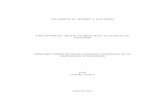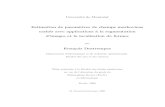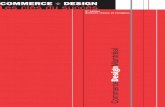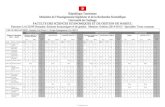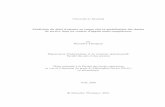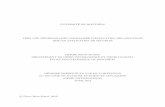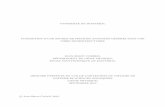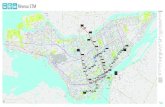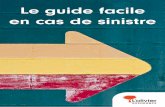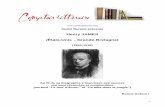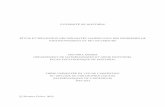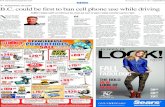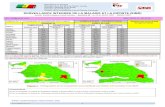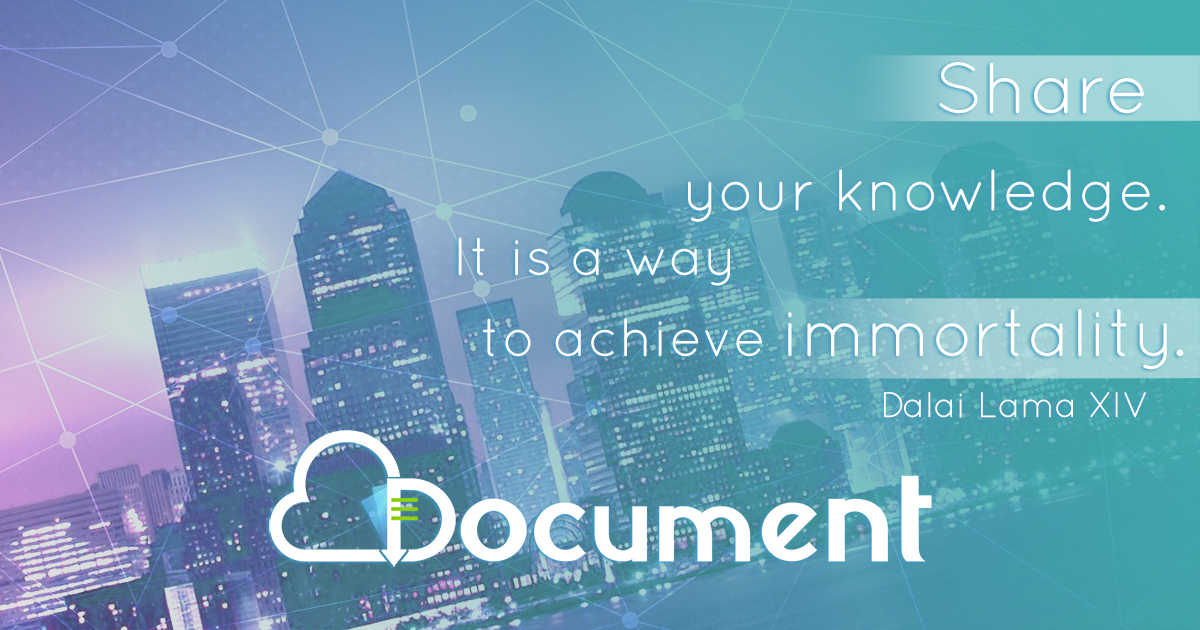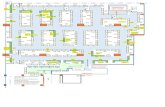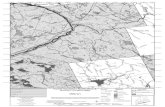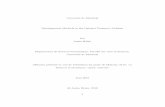$ 0&!.$1$+'-2#! · 0&!.$1$+'-2#! 15 mars 2018 Maison Shaughnessy, CCA (Centre Canadien...
Transcript of $ 0&!.$1$+'-2#! · 0&!.$1$+'-2#! 15 mars 2018 Maison Shaughnessy, CCA (Centre Canadien...

A.I. BETWEEN HUMOUR,
FEAR & UTOPIA
15 mars 2018
Maison Shaughnessy, CCA (Centre Canadien d’Architecture)
Montréal, Canada
GLUON.BEplatform for art, science
and technology

2

3
INTRODUCTION
A.I.: between humour, fear and utopia
Dans le cadre de la visite de leurs Majestés le Roi et la Reine des Belgesà Montréal, GLUON et BOZAR Lab, avec le soutien de la Région de Bruxelles-Capitale, ont le plaisir de présenter l’exposition A.I.: between humour,fear and utopia au Centre Canadien d’Architecture. Pour cetteexposition, nous avons invité des artistes ayant un lien avec Bruxelles pour présenter des œuvres qui s’appuient sur des algorithmes d’intelligenceartificielle ou engagent une réflexion sur cette technologie.
L’intelligence artificielle se développe à une vitesse fulgurante. L’intérêt et les attentes que suscitent ces avancées sont énormes. Par ailleurs, beaucoup de capitaux sont investis dans ces nouvelles technologies et dans la recherche d’innovations prometteuses. Avec les progrès les plus récents dans les domaines du « deep learning », du « self-learning neural network », de la robotique et des « big data », nous découvrons dans de nombreux domaines des possibilités illimitées.
Mais les opinions sur l’impact de l’intelligence artificielle sur la société sont très divergentes. Des scientifiques et des industriels comme Stephen Hawking,Elon Musk et Bill Gates nous avertissent que l’I.A. pourrait entraîner la fin de l’humanité et ils appellent à en prendre conscience. D’un autre côté, le philosophe Daniel Dannet est plus critique : à l’heure actuelle, nous sommesencore incapables d’expliquer la conscience, alors comment pourrions-nous créer un ordinateur dont l’intelligence en viendrait à dépasser la nôtre ?
En conséquence, il est important que des artistes se penchent sur la question de l’impact sociétal de ces évolutions technologiques. Les artistes révèlent les interactions entre humains et algorithmes et mettent en lumière les systèmeset structures qui sous-tendent l’intelligence artificielle. Leur réflexion sur les implications de ces innovations porte ainsi sur des aspects qui dépassent les sphères technologique et économique et touchent aux domaines culturel, psychologique, philosophique et spirituel. Ils nous permettent de portersur ces technologies un regard empreint d’humour et d’inquiétude, d’espoir et de résignation.
Les artistes ayant contribué à cette exposition travaillent de plus en plus avec des algorithmes d’intelligence artificielle utilisés pour diverses applicationsconcrètes comme la reconnaissance d’images ou le traitement automatique de langage naturel. En collaborant avec des spécialistes, ces artistes explorent les enjeux au cœur de ces technologies. De ce fait, ils stimulent l’inévitable débat sur le rôle de l’art dans le domaine de l’intelligence artificielle et sur la définition de la créativité dans un contexte de rapides transformations.
Nous tenons à vous remercier pour votre visite et nous espérons que cela pourra être le point de départ d’une exposition de plus grande envergure explorant les intersections entre les arts et l’intelligence artificielle. Montréal, en tant que foyer pour la recherche dans le domaine du « deep learning », semble être un terrain idéal pour une collaboration future avec des chercheurs et artistes européens.
Christophe De Jaeger Paul DujardinFounder & Director Gluon Chief Executive Officer – Artistic Director BOZARHead of BOZAR Lab

4

5
A.I.: between humour, fear and utopia
Within the framework of the visit of Their Majesties the King and Queen of the Belgians to Montréal, GLUON and BOZAR Lab, with the support of the Governementof the Brussels-Capital Region, are proud to present the exhibitionA.I.: between humour, fear & utopia in the Canadian Centre for Architecture.For the exhibition, we invited artists connected to Brussels to presentworks that reflect upon or work with A.I. technologies.
We are in the midst of rapid A.I. innovation. Interest and expectations are at an all-time high and the latest developments are astonishing. In the same time, much investment capital is being injected into these new technologies and the search for promising innovations. With the latest advancements in deep learning, self-learning neural networks, robotics and the availability of an enormous amount of data, we are looking towards endless possibilities in many different fields.
But opinions on the impact of A.I. developments on society are very diverse. Scientists and industrialists such as Stephen Hawking, Elon Musk and Bill Gates warn that A.I. could spell the end of the human race and urge people to be aware of it. On the other hand, the philosopher Daniel Dannet is much more critical; today, we cannot even explain consciousness, so how would we produce a computer that becomes smarter than ourselves?
Therefore, it’s important to have artists that reflect on the societal impactof these technological evolutions. They make the systems and structuresbehind A.I. visible and reveal the interplay between humans and algorithms.They hereby shift their focus beyond the technological and economic horizonto scrutinize the implications of these innovations in cultural,psychological, philosophical and spiritual spheres. Their works let us look with fear and humor, as well as utopia and fate, towards A.I.
The artists selected for this exposition are working increasingly with A.I. solutions and algorithms in different fields, such as image recognition and natural language processing. Together with ICT experts, they explore differentplatforms and get a better feeling for the dangers and challenges of thesetechnologies. By doing so, they stimulate the inevitable debate about the role of arts in A.I. and the definition of creativity in a state of rapid transformation.
We thank you for your visit and we hope it might be the starting point for a larger exhibition exploring the intersection of the arts and artificalintelligence. Montreal, a world leader in this field and a hub for distinguished deeplearning researchers, seems to be the most fertile soil for a futurecollaboration with European artists and researchers.
Christophe De Jaeger Paul DujardinFounder & Director Gluon Chief Executive Officer – Artistic Director BOZARHead of BOZAR Lab
INTRODUCTION

6

7
LISTE DES OEUVRES
Trophy Camera | Max Pinckers & Dries Depoorter
Talk to me | Jonas Lund
xxx-cavat0r | Frederik De Wilde
DEEP FLAW - AI]Mix | Frederik De Wilde
Pavilions of Memory | Taline Temizian
Temps Mort / Idle times | Alex Verhaest
A.I. object recognition, Infrathin | Jerry Galle
The Kitty A.I.: Artificial Intelligence for Governance | Pinar Yoldas
8
9
10
11
12
13
14
16

8
Trophy Camera is a photo camera that can only take award-winning pictures.Just take your photo and check if the camera sees your picture as award winning. This A.I.-powered camera has been trained by all previous winning World Press Photos of the year. Based on the identification of labeled patterns, the camera is programmed to recognise,make and save only winning photos, which are automatically uploaded to the dedicated website: trophy.camera.
Trophy Camera est un appareil photoqui n’est capable de prendre que des clichés dignes d’une recompense. Il suffit de prendre une photo et de voir si l’appareil la juge de qualité suffisante. Cet appareil fonctionnantavec un algorithme d’intelligence artificielle a été entraîné avec toutesles photographies lauréates de la compétition World Press Photo. Sur base de l’identification de certainscritères, il est programmé pour ne sauvegarder que les clichés qui pourraient être primés. Ceux-ci sont alors automatiquement mis en lignessur le site web trophy.camera.
Max Pinckers en collaboration avec Dries Depoorter Trophy Camera (2017)
Trophy Camera v0.9 © Max Pinckers & Dries Depoorter, Courtesy: FOMU, Anvers

9
Talk to me is a conversational chat bot, a chat bot that has been trainedand modelled on all previous instantmessage conversations (Skype, WhatsApp,Facebook messenger) as typed by the artist himself to create a smart, machinelearned, automatically talking versionof the artist. As you converse, the chat bot will reply speaking with a voice that is a text to speech synthesised version of the artist’s voice, created by recording over a 1000 sentences. As a gesture towards eternalisation, the TTS voice of the artist is free to download and use in replacement of Siri or other smart speaking devices. At the exhibition, you can have a conversation with the artist, without the artist being present.
Talk to me est un chatbot conversationnel. Jonas Lund l’a entraîné et modelé sur base de toutes ses conversations de messages instantanés (Skype, Whatsapp, FacebookMessenger) pour créer une copie intelligente de lui-même, capable de communiquer à sa manière. Lorsque vous écrivez au chatbot, il vous répond avec la voix synthétisée de l’artistesur base de plus de 1000 phrases pré-enregistrées, grâce à un procédéde conversion de texte en parole. Dans cette exposition, il est donc en quelque sorte possible de parler avec l’artiste sans qu’il ne soit présent. Par ailleurs, la voix synthétisée de Jonas Lund peut être téléchargée et utilisée en remplacement de Siri ou d’autres logiciels de commande vocale– une tentative assumée de l’artistevers une forme d’immortalité.
Jonas LundTalk to me (2017)
Talk To Me, vue de l’installation, Huset for Kunst & Design, HolstebroPhotographe: © David Stjernholm, Courtesy: Jonas Lund

10
xxx-cavat0r est une œuvre interactive à la lisière de l’art, la science et la technologie qui explore les notionsde paysage, d’archive, de physique quantique et de cosmologie. Elle est réalisée sur base de données (nuagede points) se référant à Bruxelles.Ces données ont été enregistrées par un drône équipé d’un scanner LiDAR.Elles sont interprétées par un procédéde « machine learning » ettransformées en son et en image pour créer de nouveaux paysages, non pas peints mais numériques. L’œuvre brouilleles frontières entre l’humain, la machine et l’algorithme, entre le réel et le factice. Elle soulève des questions sur les thématiques du contrôle, du respect de la vie privée, de l’automatisation, ainsi que sur les concepts traditionnels de créativité et de paternité sur une œuvre artistique.
xxx-cavat0r is the first iteration of an interactive and generative artworkon the fringe of art, science and technology exploring the notions of the landscape, archive, quantum physics and cosmology. The artwork is based on point cloud data -for the occasionspecifically from the city of Brussels-registered with a drone equippedwith a LiDAR scanner, and interpretedby machine learning to create new ad hoc digital landscapes. The resultis not a painted landscapebut a digital one that is visualised,sonified and ‘dreamed’ by an A.I. The artwork blurs and erodes the lines between man, machine and algorithms, real and fake and raises questions on the topics of control, trust, privacy,security, automatisation and the traditional concepts of creativity and authorship in the field of art.
Frederik De Wilde en collaboration avec Denis Perevalov (creative coding)xxx-cavat0r (2018)
xxx-cavat0r © Frederik De Wilde, 2018 Courtesy: Frederik De Wilde

11
DEEP FLAW- AI)Mix is an A.I.-generatedand evolutionary computationally-driven3D-printed sculpture. The sculpture is made of evolved source images (i.e. a piggybank, Mickey Mouse, perfume bottle, etc)assembled by the artist into one 3D model. The result is an abstract object that looks utterly strange and funny to us, but which an A.I. still recognisesas a piggy bank or Mickey Mouse.
Advances in supervised learning with deep neural networks have enabled robust classification in many real-world domains. An interesting questionis: can such advances also be used for computational creativity? DEEP FLAW – AI]mix demonstrates that deep networkstrained on typical supervised taskscan be used as an ingredient in an evolutionary algorithm driven towards creativity. The conclusion is that combining evolutionary algorithmsand deep learning in this way provides new possibilities for creative generation of meaningful and novel content from large labelled datasets.
DEEP FLAW – AI]mix est une sculptureévolutive en 3D générée par uneintelligence artificielle. La sculptureest réalisée sur base d’imagessources (un cochon tirelire, MickeyMouse, un flacon de parfum, etc) qui ont été déformées puis transposées par l’artiste en un modèle3D. Le résultat est un objet abstrait qui semble bien étrange à nos yeux mais reste tout à fait identifiable par une intelligence artificielle.
Les progrès dans l’apprentissage supervisé avec le « deep learning » ont permis de mettre en place des systèmesde classification robustes dans de nombreux domaines. Ces progrès peuvent-ils également être mis au service de la créativité dans le domainenumérique ? DEEP FLAW – AI]mix démontrequ’en effet, des réseaux profondsentraînés avec des tâches superviséespeuvent faire partie intégranted’un algorithme évolutif utiliséà des fins créatives. On peut en déduirequ’une telle combinaison d’algorithmesévolutifs et du « deep learning »offre de nouvelles possibilitéspour la création de contenus sur base de données labellisées.
Frederik De WildeDeep Flaw – AI]Mix (2017)
DEEP FLAW – AI]Mix ©Frederik De Wilde, 2017 Courtesy: Frederik De Wilde

12
Image du film Pavillions of Memory (The Networks Project), 2018 © Taline Temizian Courtesy: Taline Temizian
Pavilions of Memory est une installationmultimédia interactive construite sur le modèle d’un cerveau imaginaire disséqué. Un cerveau disséqué semble très différent selon qu’il est vu de face ou de côté. L’œuvre reproduit cetteidée dans la manière dont elle est construite et dans ce qu’elle transmet. L’installation recrée également un système de code couleurs et un systèmede grilles qui combine des souvenirs de l’artiste, des données sur son proprecerveau collectées par IRM, des représentations de ses souvenirs et des sons. On peut voir à l’écran un mélange algorithmique de toutes ces données mêlées à des données sur le public provenant d’une webcam. Ainsi,la mémoire de l’artiste et les actionsdu public se confondent.
Pavilions of Memory is an interactive multi-media installation constructed like an imaginative dissected brain. Physically, a dissected brain looks very different when viewed from different perspectives: the side vs. the front. The structure of the piece explores this notion in the way it is constructed and what it represents and transmits.
The installation also recreates a color-coding system, a grid system that combines memories of the artist’slife as well as data from her own brain from FMRI-s and representationsof her proxy memories and noise. Theseare technically coded and perform a certain algorithmic function shown on a monitor as reconstructed neuralcinematic movies when combined with the audience’s input through a webcam.The results are ever-changingpossibilities of outputs.
Taline Temizian en collaboration avec Beatrice de Gelder, chercheuse en neurosciencesPavilions of Memory (The Networks Project) (2018)

13
Temps Mort / Idle times is an experimental film relating the story of a family embroiled in an age-old family drama. The story is spread out across a wide range of distinct works, each depicting a scene and each attemptingto engaging the viewer with interactiveelements. Spectators are encouraged to form bonds between these disparateelements. The work is an ongoing investigation into the mechanismsof film and a research into how interactivity can add to a story. A conversation between the characters starts after visitors call the numberfrom a call card and the phone on the table in the scene starts to ring.
Temps Mort / Idle times est un film expérimental qui raconte l’histoired’une famille au coeur d’un drame familial. L’histoire est dispersée au travers d’un éventail d’oeuvres distinctes, chacune d’elle représentantune scène spécifique et visant à impliquerle public par des éléments interactifs. Les spectateurs sont incités à faire des liens entre ces différentes facettes.Le projet explore la mécanique du médiumdu film et la manière dont le publicpeut contribuer à l’histoire en interagissant avec elle. Après que le spectateur ait appelé le numéro indiqué près de l’oeuvre, le téléphone posé sur la table se met à sonner et les personnagescommencent une conversation.
Alex VerhaestTemps Mort / Idle times (2015)
Image du film Temps Mort / Idle times © Alex Verhaest, 2015 Courtesy: Dauwens & Beernaert

14
A.I object recognition, Infrathin © Jerry Galle, 2017 Courtesy: Jerry Galle

15
A.I. object recognition, Infrathin explores the use of language that is co-created with artificial intelligentalgorithms. What does it mean when machines start to identify objects and images? In this piece, Galle used machinelearning image recognition to describe3D printed objects such as; a urinal.The resulting descriptions resemblethe writings of a deranged art critic,trying to pin an artwork using apoetic approach.
In addition the descriptions tend to be biased and refer to the web – asa consequence of feeding the machinelearning system with data (images) from online sources. For example, when it sees a black object it will make racialreferences if that object has the slightest affinity with a human body or a face. This can generate hilarious explanations, to say the least. But these descriptions can also unwillinglybecome offensively invasive and prejudiced. The descriptions of the objects generated by image recognition seem to have more affinity with memes, and therefore with humor, than with actual (scientific) image recognition.
A.I. object recognition, Infrathin explore les usages du langage créé avec des algorithmes d’intelligence artificielle. Qu’est-ce que cela implique que des machines se mettent à identifier des objets et des images ?Dans cette œuvre, Galle a utilisé un logiciel de reconnaissance d’image pour décrire des objets imprimés en 3D tels qu’un urinoir. Les descriptions qui en résultent ressemblent aux écrits d’un critique d’art dérangé qui tenterait de parler d’une œuvre de manière poétique.
Par ailleurs, ces descriptions sont biaisées et elles font essentiellementréférence aux contenus du web – le logiciel est en effet alimenté par des données (images) provenant de sourcesen lignes. Cette reconnaissance d’imageest dépourvue de filtre. Par exemple,lorsque le logiciel identifie un objetnoir, il établira des références raciales si cet objet comporte la moindre ressemblance avec un corps humain. Bien que ces résultats puissentparfois être très drôles, ils peuventaussi apparaître comme des préjugésoffensifs. Les descriptions des objetscrées par le logiciel de reconnaissanced’images semblent avoir plus de similitudes avec les mèmes, et donc avec l’humour, qu’avec la reconnaissanced’images scientifique.
Jerry GalleA.I. object recognition, Infrathin (2017)

16
Image du film “The Kitty A.I. Artificial Intelligence for Governance” © Pinar Yoldas, 2016 Courtesy: Pinar Yoldas

17
The Kitty A.I.: Artificial Intelligence for Governance is a video installationand peripheral artistic material such as posters, apps, objects. The narrative projects a speculative future scenario in which an artificialintelligence in the form of a kittenhas replaced the governing elite.
It is year 2039. In a “politician-free zone” the Kitty A.I. reigns supreme as the ultimate governor of a European city. R-Crisis EMEA, a refugee crisistriggered by war and climate change,is followed by P-Crisis EMEA, a political crisis where many politicians across Europe and EMEA countries fail to serve the sentient human. Kitty A.I. is an artificial intelligence with the affective capacities of a cat who can love up to 3 million people. The KittyA.I. not only carries the tasks of a governor but also takes care of its citizens at a personal level. A fun take on the future of A.I., governance and cats, the piece does not fail to entertainwhile inspiring critical thinking.
The Kitty A.I. : Artificial Intelligence for Governance consiste en une installation vidéo accompagnée de matériel artist que périphérique comme des posters et des objets. L’œuvres’appuie sur le scénario d’un futurimaginaire dans lequel l’élite du gouvernement a été remplacée parune intelligence artificielle sous laforme d’un chaton.
Nous sommes en 2039. Dans une « politican-free zone », Kitty A.I. règnesur une ville européenne en maître suprême. R-Crisis EMEA, une crise des réfugiés déclenchée par la guerre et les changements climatiques, a été suivie de P-Crisis EMEA, une crise politique dans laquelle de nombreux politiciens d’Europe et de pays EMEA ont échoué à servir l’être humain, dotéde sensibilité. Kitty A.I. est une intelligence artificielle avec les capacités affectives d’un chat qui peut aimer jusqu’à 3 millions de personnes. En plus d’endosser le rôle de gouverneur, elle prend soin de ses citoyens sur le plan personnel. Prenantune position amusante sur le futurde l’intelligence artificielle, la gouvernance et les chats, l’œuvre nemanque pas de faire sourire tout enéveillant une pensée critique.
Pinar YoldasThe Kitty A.I.: Artificial Intelligence for Governance (2016)

18
Since its inception, Gluon has raisedawareness of global challenges. A flourishing society builds on balancedinteraction between humans, their technological achievements and their natural environment. Interactions between experts from different sectors and artists are vital in a common search for solutions to the challenges that affect this system. Therefore, Gluondeveloped a platform that maximizescollaborations and cofrontations between artists, researchers, industrialists, young people and active citizens.
Gluon connects artists with researchersin universities, research institutionsand companies. At the same time, it supports residencies of scientists in the studios of artists. These interactions can lead to artistic and philosophical outcomes or innovativeideas, services and products in non-artistic sectors, such as education,health care, ecology, cultural diplomacyand community building.
Besides fostering these bridges betweenart, science and technology, Gluondevelops a programme of lectures and exhibitions in order to highlight the results of the interactions betweenartists, researchers and companies initiated by Gluon, as well as the role of art as a catalyst for scientificand technological knowledge. Gluonalso regularly organizes pop-up demonstrations and workshops that stimulate education in the field of science, technology and the arts.
In order to carry out its mission, Gluonengages alliances with a growingnumber of cultural, educational and university partners in Belgium and abroad, such as the Centre For Fine Arts (BOZAR, Brussels), Erasmus Hogeschool Brussel (EhB, Brussels), iMal (Brussels), Budafabriek (Kortrijk), Vooruit (Ghent), Zebrastraat (Ghent) and Ars Electronica (Linz, Austria).
Website: www.gluon.be
GLUON
Depuis sa création, Gluon explore les défis majeurs qui affectent notresociété. Une société prospère se construit sur un équilibre entre les humains, leurs réalisations technologiques et leur environnement.Les échanges entre artistes et chercheurs de différents secteurspour une recherche commune de solutionssont essentiels à cet équilibre. Pourcette raison, Gluon fournit une plateforme d’échange entre des artistes,des chercheurs, des industriels,des citoyens actifs et des jeunes.
Gluon met en lien des artistes avec des universités, des institutions de recherche et des entreprises. En parallèle, Gluon organise l’accueil de scientifiques dans les studios d’artistes. Ces interactions peuventavoir un impact dans le domaine artistique et philosophique et être source d’idées de produits novateursen matière de santé, d’écologie,de diplomatie culturelle et de« community building ».
Par ailleurs, Gluon met en place une programmation de conférenceset d’expositions afin de présenterles résultats des collaborationsqu’il a initiées. Gluon organise également des démonstrations de nouvelles technologies et des ateliers auprès des jeunes dans le but de favoriserl’éducation artistique, scientifique et technologique.
Afin de mener à bien sa mission, Gluon établit un nombre croissant de partenariats avec des institutions cul-turelles, des écoles supérieures et des universités en Belgique et à l’étran-ger tels que le Palais des Beaux-Arts (BOZAR, Bruxelles), Erasmus Hoge-school Brussel (EhB, Bruxelles), iMAL (Bruxelles), Budafabriek (Courtrai), Vooruit (Gand), Zebrastraat (Gand) et Ars Electronica (Linz, Autriche).
A PROPOS

19
BOZAR Lab is a new department within BOZAR that explores how new technologiescan affect museum experience and its audiences. It works at the intersectionof BOZAR’s different disciplines (visualarts, music, cinema, theatre, literature,agora) and transversal programmes. BO-ZAR Lab connects the different artistic departments and its many cultural artistic partners with innovative companies, start-ups, experts andresearchers in the field of science and technology.
BOZAR Lab consists of three different pillars:the residency programme, the exhibition programme and the reflection platform. Through these pillars, BOZAR Lab nourishes hybrid links between its artistic and technological stakeholdersand fosters creativity, critical reflection and innovation in the fields of art, culture, science and technology.
Website: www.bozar.be
BOZAR LAB
BOZAR Lab est un nouveau département de BOZAR qui explore la manière dont les nouvelles technologies peuvent avoir un effet sur les spectateurs et sur leur expérience dans un espace muséal. Il se situe à la croisée des différentesdisciplines de BOZAR (les arts visuels,la musique, le cinéma, le théâtre, la littérature et agora). BOZAR Lab met en place des relations transversalesentre les différents départements artistiques et les partenaires artistiques et culturels de BOZAR, d’une part, et des entreprises, des start ups, des experts et des chercheursdans les domaines de la science et de la technologie, d’autre part.
BOZAR Lab repose sur trois piliers: un programme de résidences, un programmed’expositions et une plateforme de réflexion. Ces piliers favorisent des liens hybrides entre les partenaires artistique et technologiques de BOZAR Lab pour faire émerger une réflexion critique, des idées créatives et des innovations dans les domaines de l’art, la culture, la science et la technologie.

20
Alex Verhaest (1985, Belgique). Vit et travaille à Bruxelles. Son travail est principalement axé sur le langage, la narration et l’impossibilitéde la communication. Le point de départ de chaque projet est un scénario très narratif, déjà existant ou récemment écrit, sur base duquel l’artiste crée un ensemble d’oeuvres en analysant l’intrigue et en explorant les limites de ce qui correspond au langage communicable. Le travail très pictural de Verhaest se trouve au croisement de la peinture et de la vidéo, chaque nouveau projet étant un examen de la technologie contemporaine. Pendant sa dernière année de Master,Verhaest a voyagé en Chine où elle a découvert la sous-culture asiatiquedes hackers. Son travail a été exposé dans de nombreux pays et a été sélectionnépar plusieurs festivals et compétitions d’art et de nouveaux médias, parmilesquels FILE Electronic Language Festival (Sao Paulo), New TechnologyArt Award (Gand), TAZ oostende et Arts Festival Watou. Alex Verhaest a récemment remporté le prestigieux prix du Japanese Media Arts Festival.
Dries Depoorter (1991, Belgique). Vit et travaille à Gand. Dries Depoorter est un artiste multimédia et un « créateur de concepts ». En travaillant avec ses propres données privées et celles d’autres personnes trouvéessur internet, il s’attaque aux questions de l’identité sociale, des « big data », du cryptage de données et de (l’absence de) protection de la vie privéesur le net. Depoorter a étudié l’électronique pendant six ans avant de se tourner vers les arts multimédias au KASK, l’Ecole d’Art de Gand, où il a obtenu son diplôme en 2015. Son travail a été présenté au Barbican Centre,Mutek Festival, BOZAR, IDFA Doclab, Mundaneum, FOMU, Ars Electronica, Athens Digital Art Festival, Art Souterrain. Depoorter a participé à d’importantes conférences et festivals : TEDx Brussels, KIKK festival, STRP festival, Mutek Montreal, Internet Week Denmark, Future Flux Festival, GetXoPhoto, Night by us, ou encore CPH transform Copenhagen. Pour l’instant il travaille, en collaboration avec BOZAR Lab, sur une nouvelle création que vous pourrez admirer lors de l’expo Theodoor van Loon, un peintre caravagesque entre Rome et Bruxelles (10.10.18-13.01.19).
Max Pinckers (1988, Belgique). Vit et travaille à Bruxelles. Max Pinckers est photographe. Il a réalisé plusieurs livres tels que Lotus (2011), The Fourth Wall (2012), Will They Sing Like Raindrops or Leave Me Thirsty (2014) et Margins of Excess (2018). Il fait pour l’instant une thèse de doctorat à l’AcadémieRoyale des Beaux-Arts de Gand (KASK). Le travail de Pinckers a été exposé au MOCAKen Pologne (2016), au Philadelphia Museum of Art aux USA (2015) et au Palais des Beaux-Arts – BOZAR en Belgique (2015), entre autres. Il a reçu plusieurs récompenses,parmi lesquelles le Edward Steichen Award (2015) et le prix Levallois(2013). En 2015, il a fondé Lyre Press, une maison d’édition indépendante.
Frederik De Wilde (1975, Belgique). Vit et travaille à Bruxelles. Frederik De Wilde travaille à la croisée de l’art, la science et la technologie.Il a étudié les beaux-arts, les arts multimédias et la philosophie. Sa pratiqueartistique porte essentiellement sur les notions de l’inaudible, l’intangibleet l’invisible, la « dark ecology » et les territoires invisibles. Un exemplecaractéristique de son travail est la conceptualisation, et la création, du « Blackest-Black Art » réalisé en collaboration avec des universités américaineset la NASA. Le projet a reçu le Next Idea Award d’Ars Electronica et le Best European Collaboration Award (entre un artiste et un scientifique). Il a fait l’objet de nombreux articles et reportages (par exemple dans HuffingtonPost, Creators Project, TED). Frederik De Wilde travaille pour l’instant en
A PROPOS DES ARTISTES

21
collaboration avec Gluon, Baltan Laboratories, KLAS Max Planck. Il préparedes résidences à Houston au Moody Center for The Arts et à l’Instituteof Biosciences and Bioengineering 26 (IBB). En 2017, il a réalisé son premiercourt-métrage, « Joy Palace », avec le soutien du Fond Audiovisuelde Flandre. Il travaille pour l’instant sur un nouveau scénario.
Jerry Galle (1969, Belgique). Vit et travaille à Gand.Jerry Galle s’intéresse aux relations parfois compliquées entre la technologienumérique et la culture contemporaine. Il utilise des logiciels récents et de l’imagerie numérique d’une manière non-conventionnelle et met en avant le rôle de la technologie dans notre vie quotidienne et dans la création artistique.Son travail explore la manière dont les images et textes technologiques peuventgénérer de nouvelles significations. Pour Galle, ces « techno-textes » et « techno-images » peuvent être géométriques ou symboliques, ludiques ou terriblement sérieux. La méfiance par rapport au numérique occupe une place majeuredans son travail. Les oeuvres de Jerry Galle ont été exposées dans les institutions suivantes: Muhka, Bozar, Museum Dhondt-Dhaenens, British Film Institute, Wiels, International Film Festival Rotterdam, EMAF, International Film Festival hamburg, Museum Dr. Guislain, Ars Electronica, entre autres.
Jonas Lund (1984, Suède). Vit et travaille à Berlin. Jonas Lund réalise des peintures, sculptures, photographies, sites web et performances qui portent un regard critique sur l’idée de réseau et sur les structures de contrôle. Il a obtenu un MA au Piet Zwart Institute, Rotterdam (2013) et un BFA à la Gerrit Rietveld Academy, Amsterdam (2009). Ses œuvres ont été exposées dans le cadre d’expositions individuelles dans les institutions suivantes: Whitechapel Art Gallery, London (2016), Steve Turner, Los Angeles(2016, 2015, 2014), Växjö Konsthall Sweden (2016), Boetzelaer|Nispen, Amsterdam(2014), Showroom MAMA, Rotterdam (2013), New Museum, New York (2012). JonasLund a participé à de nombreuses expositions de groupes, notamment chez Carrol/Fletcher, London, ZKM, Karlsruhe, Van Abbemuseum, Eindhoven, WitteDe With, Rotterdam, De Hallen, Haarlem et Moving Museum, Istanbul. Son travaila fait l’objet d’articles dans Artforum, Kunstforum, Metropolis M,Artslant, Rhizome, Huffington Post, Furtherfield, ou encore Wired.
Pinar Yoldas (1979, Turquie). Vit et travaille à San Diego, USA. Pinar Yoldas est représentée par White Circle, une galerie Bruxelloise fondée etdirigée par Nicolas Wierinck. Son travail s’appuie sur la biologie et les technologies digitales et se développe au travers d’installations architecturales, de sculptures, de sons, de vidéos et de dessins. Les thématiques auxquelles l’artiste s’intéresse sont le post-humanisme,l’éco-nihilisme, l’Anthropocène et la technoscience féministe. Yoldas a un Bachelor en Architecture de la Middle East Technical University, un Master en Arts de la Bilgi University, un Master en Sciences de l’Université Technique d’Istanbul, un Master en Arts de l’Université de Californie, Los Angeles, ainsi qu’un certificat en neurosciences cognitives. Elle a par ailleurs obtenu un Ph.D de la Duke University avec la these « Speculative Biology : New directions in Art in the Age of the Anthropocene ». Ses expositions individuelles récentes incluent : The Warm, the Cool and the Cat au Roda Sten Konstall Sweden, An Ecosystem of Excess, Polytech Museum, Moscou (2015) et AlterEvolution, Ekavart, Istanbul (2013). Par ailleurs, ses oeuvres ont été présentées dans les expositionsde groupe suivantes: WATER.WAR, Gluon, Bruxelles (2016), PLANET B - 100 ideasfor a new world, NRW-Forum Düsseldorf (2016), SALTWATER, 14ème Biennale d’Istanbul

22
(2015), ExoEvolution, ZKM, Karlsruhe (2015), Tiere und Menschen, Museum Ostwall,Dortmund (2014), Transmediale Festival, Berlin (2014) et thing World: InternationalTriennial of New Media Art, NAMOC National Art Museum of China, Beijing. Yoldas a reçu de nombreux prix, parmi lesquels le prestigieux John Simon Guggenheim Memorial Foundation Fellowship in Fine Arts en 2015.
Taline Temizian (1978, USA). Vit et travaille entre Bruxelles et Londres.Taline Temizian est une artiste et transhumaniste qui utilise des systèmes, des signes et des processus pour explorer les interactions entre l’histoire personnelle et l’histoire culturelle au travers de la science, la technologie,la philosophie et la poésie. Sa pratique est marquée par de nombreuses influencesallant de la peinture moderniste à l’anthropologie en passant par l’imagerieet la recherche médicale contemporaine, en particulier dans le domainede la cardiologie et des neurosciences. Taline Temizian fait des études en Design & Coding à Londres. Elle a par ailleurs un Bachelor en Literature& Linguistic sciences, un Master en Visual Communication à UAL et un diplômeen Fashion Design. Son travail a été présenté dans de nombreuses plateformescomme Artsy, ArtAndOnly, dans des espaces et collectifscomme Empire II, ainsi qu’au sein de projets et expositions de groupes. Son travail fait partie de collections privées et publiques de par le monde.

23
Alex Verhaest (b.1985, Belgium). Lives and works in Brussels. Alex Verhaest’s work is largely focused on language, story and the impossibility ofcommunication. The basis of each project is a highly narrativescript, existing or newly written, around which she creates a body of work by analyzing its storyline and exploring the limits of what constitutes communicable language. Verhaest’s highly pictorial work operates on the juxtaposition of painting and video, each new project being an investigation into unorthodox contemporary technology. During her MFA year, Verhaest travelledto China where she discovered the Asian hacker subculture. Her work has been exhibited internationally and has been selected by several arts and new media festivals and competitions; i.e. the FILE electronic language festival in Sao Paolo,the New Technology Art Award in Gent, TAZ oostende and Arts Festival Watou. Alex Verhaest recently won the prestigious award of the Japanese Media Arts Festival.
Dries Depoorter (b. 1991, Belgium). Lives and works in Ghent.Dries Depoorter is a media artist and concept provider. Assembling, sharing and experimenting with private data of himself and random people found on the internet, he tackles, in a thought-provoking way issues like social identity, big data sharing, encryption and (the lack of) protection of our online privacy. Depoorter studied electronics for six years before making the switch to media arts at the KASK School of Arts Ghent, where he graduated in 2015. His work has been exhibited internationally at the Barbican Centre, Mutek Festival,Bozar, IDFA Doclab, Mundaneum. FOMU, Ars Electronica, Athens DigitalArt Festival, Art Souterrain, MU and he did talks for important festivals:TEDx Brussels, KIKK-festival, STRP festival, Mutek Montreal, Internet Week Denmark, Future Flux Festival, GetXoPhoto, Night By Us, CPH transform Copenhagen. Dries De Poorter is currently collaborating with BOZAR Lab on a new creation that will be presented at BOZAR during the exhibition Theodoor van Loon, a Caravaggist painter between Rome and Brussels (10.10.18-13.01.19).
Max Pinckers (b.1988, Belgium). Lives and works in Brussels. Max Pinckers is a photographer who has produced various photobooks such as Lotus(2011), The Fourth Wall, (2012), Will They Sing Like Raindrops or Leave Me Thirsty (2014) and Margins of Excess (2018). He is currently a doctoralresearcher in the Arts at the Royal Academy of Fine Arts (KASK) in Ghent. Pinckers has had exhibitions at the MOCAK in Poland (2016), the Philadelphia Museum of Art in the United States (2015) and the Centre for Fine Arts - Bozar in Belgium (2015), among others. Awards include the EdwardSteichen Award (2015) and the City of Levallois Photography Award (2013). In 2015 he founded the independent publishing imprint Lyre Press. Frederik De Wilde (b.1975, Belgium). Lives and works in Brussels.Frederik De Wilde works at the interstice of the art, science and technology.He studied fine arts, media arts and philosophy. The conceptual cruxof his artistic praxis are the notions of the inaudible, intangible andinvisible, dark ecologies and invisible territories. An excellent exampleis the conceptualisation, and creation, of the Blackest-Black Art madein collaboration with American universities and NASA. The projectreceived the Ars Electronica Next Idea Award and the Best European Collaboration Award between an artist and scientist, extensivelycovered (e.g. Huffington Post, Creators Project, TED). Frederik De Wilde
ABOUT THE ARTISTS

24
is currently collaborating with GLUON, Baltan Laboratories, KLASMax Planck and preparing residencies at the MOODY Center ForThe arts in Houston and the Institute of Biosciences and Bioengineering 26 (IBB) in Houston. In collaboration with Stratasys Ltd. De Wilde is currentlycreating an artwork for the ‘New Ancient’ collection (e.g. Zaha Hadid,Neri Oxman) and a jewel (e.g. Jenny Lu). In 2017, he made his first short film ‘Joy Palace,’ supported by the Flemish Audiovisual Fun. He is currently working on a new script.
Jerry Galle (b.1969, Belgium). Lives and works in Ghent. Jerry Galle’s work is all about the sometimes-difficult relationship between digitaltechnology and contemporary culture. He uses recent software and digitalimagery in an unconventional way and stresses the role of technologyin our daily life and artistic creation. His work explores the way howtechnological images and texts can produce new meaning. For Gallethese ‘techno-texts’ and ‘techno-images’ can be geometrical or symbolic, playfulor dead serious. Digital doubt plays an important role in his work. His work has been shown in Muhka, BOZAR, Museum Dhondt-Dhaenens, British Film Institute, Wiels, International Film Festival Rotterdam, EMAF, International Film Festival Hamburg, Museum Dr. Guislain, Ars Electronica and many others.
Jonas Lund (b.1984, Sweden). Lives and works in Berlin. Jonas Lund creates paintings, sculpture, photography, websites and performances that critically reflects on contemporary networked systems andpower structures of control. He earned an MA at Piet Zwart Institute, Rotterdam (2013)and a BFA at Gerrit Rietveld Academy, Amsterdam (2009). He has had solo exhibitions at Whitechapel Art Gallery, London (2016), Steve Turner, Los Angeles (2016, 2015, 2014), Växjö Konsthall Sweden (2016), Boetzelaer|Nispen, Amsterdam (2014), Showroom MAMA, Rotterdam (2013), New Museum, New York (2012), and has had work included in numerous group exhibitions including at Carrol/Fletcher, London, ZKM, Karlsruhe, Van Abbemuseum, Eindhoven, Witte De With, Rotterdam, De Hallen, Haarlem and the Moving Museum, Istanbul. His work has been written about in Artforum,Kunstforum, Metropolis M, Artslant, Rhizome, Huffington Post, Furtherfield,Wired and more. Jonas Lund is currently collaborating with GLUON on anew creation in collaboration with the Belgian company Televic.
Pinar Yoldas (b.1979, Turkey). Lives and works in San Diego, USA. Pinar Yoldas is represented by White Circle, a Brussels-based gallery founded anddirected by Nicolas Wierinck. Her work develops within biological sciences and digital technologiesthrough architectural installations, sculpture, sound, video and drawingwith a focus on post-humanism, eco-nihilism, Anthropocene and feministtechnoscience. Yoldas holds a Bachelors of Architecture from MiddleEast Technical University, a Master of Arts from Bilgi University,a Master of Science from Istanbul Technical University and a Masterof Fine Arts from University of California, Los Angeles and a certificatein cognitive neuroscience. She holds a PhD from Duke University with the thesis “Speculative Biology: New directions in Art in the Age of the Anthropocene”.Her recent solo exhibitions include: The Warm, the Cool and The Cat at Roda Sten Konstall Sweden, An Ecosystem of Excess, Polytech Museum, Moscow (2015) and AlterEvolution, Ekavart, Istanbul (2013). Amongst her most recent group shows: WATER.WAR, Gluon, Brussels, BE (2016), PLANET B - 100 ideas for a new world, NRW-Forum Düsseldorf, DE (2016), SALTWATER 14th Istanbul Biennial (2015), ExoEvolution at ZKM (2015), Tiere und Menschen,

25
Museum Ostwall, Dortmund (2014), Transmediale Festival, Berlin (2014) and thing World: International Triennial of New Media Art, NAMOC National Art Museum of China, Beijing CN. Amongst her many recognitions Yoldas received in 2015 the prestigious John Simon Guggenheim Memorial Foundation Fellowship in Fine Arts.
Taline Temizian (b. 1978, USA). Lives and works between Brussels and London. Taline Temizian is a multimedia artist and transhumanist. She usessystems, signs and processes to explore the interplay between personalnarrative and cultural history through science, technology, philosophy and poetry. Her practice is characterised by a wide range of influences,from modernist painting and anthropology to contemporary medicalimaging and research, particularly that of cardiology and neuroscience. She is currently studying Design & Coding in London. Her academic record spans from a degree in Literature & Linguistic sciences, Graduate Certificatein Visual communication at UAL and a diploma in Fashion Design. Her work is featured on multiple platforms such as Artsy, ArtAndOnly and project spaces as well as collectives like Empire II and group shows and projects.Her work is held internationally in private and public collections.

26

27
This publication has been published for the exhibition A.I.: between humour, fear and utopia curated by GLUON / BOZAR Lab with the kind support of the Government of the Brussels-Capital Region.
A special thanks to the CanadianCentre for Architecture for hostingthe exhibition at the Maison Shaughnessy in Montreal, Canada.
The exhibition has been curated by Gluon & co-produced by Gluon / BOZAR Lab.
Participating artists include FrederikDe Wilde, Jonas Lund, Dries Depoorter, Max Pinckers, Taline Temizian, Pinar Yoldas,Jerry Galle and Alex Verhaest.
With the kind support of: Government of the Brussels-Capital Region, Brussels International, Brussels Invest & Export.
Partners: Le Printemps Numérique.
Cette publication a été éditée à l’occasion de l’exposition A.I.: betweenhumour, fear and utopia, organiséepar Gluon / Bozar Lab avec le soutiendu Gouvernement de la Région deBruxelles-Capitale.
Nous tenons à exprimer nos remerciementsau Centre Canadien d’Architecture pour l’accueil de cette exposition à la MaisonShaugnessy à Montréal, Canada. L’exposition a été conçue par Gluon et co-produite par Gluon / Bozar Lab.
Les artistes représentés sont FrederikDe Wilde, Jonas Lund, Dries Depoorter, Max Pinckers, Taline Temizian, Pinar Yoldas,Jerry Galle et Alex Verhaest. Avec le soutien de: Gouvernement de la Région de Bruxelles-Capitale, Brussels International, Brussels Invest & Export.
Partenaire: Le Printemps Numérique.

CONTACT GLUONRue de l’Abattoir 4-6
1000 Bruxelles
www.gluon.be
GLUON.BEplatform for art, science
and technology
